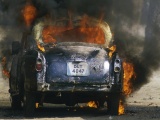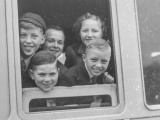
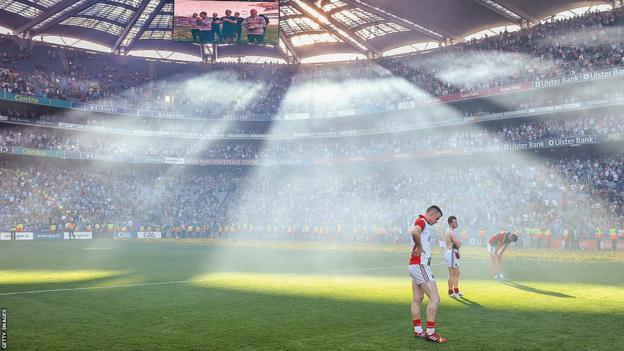
Sign up for notifications to the latest Insight features via the BBC Sport app and find the most recent in the
The mourners, dressed in black, cloaked in silence, hear it before they see it.
At first, the noise is far off. But that distant commotion is getting closer, clearer and louder.
It is the rumble of a heavy diesel engine, mixed with the lighter sound of happy shouts and laughter.
From the cemetery, they watch as an open-backed lorry rolls round the corner, loaded with fresh-faced young men and festooned with red and green ribbons.
On board are County Mayo's all-conquering Gaelic football team. They are on their way back from another epic victory, having clinched the 1951 All-Ireland title in front of 78,000 people in Dublin's cavernous Croke Park.
It is their second consecutive win in the season's biggest game and a successful defence of the revered Sam Maguire Cup.
But, some things are even more important.
Especially in 1950s Ireland, a place of deep belief and strong tradition.
A funeral demands the team fall silent, stop and pay their respects. But, too caught up in their celebrations, Mayo don't. The lorry motors on, the party continues and a sacrilege is committed.
The priest at the head of the funeral procession fixes the players with a stare and narrows his eyes.
"Damnation be upon every one of you," he says.
"As long as you all shall live, County Mayo will never win another All-Ireland."
It is a compelling story. Whether it is fact or fiction though is hard to say.
What is true, is that more than 70 years and 11 final defeats since that day, Mayo still have not won another All-Ireland final and the curse - whether it was actually uttered or not - has loomed larger and larger over Mayo and its team.
- a three-part podcast series for BBC World Service's Amazing Sport Stories - speaks to coaches, fans, historians and players, including one who was on the lorry that day in 1951, to get to the bottom of one of sport's longest and most painful jinxes.

Mayo, perched on the Republic of Ireland's Atlantic coast, is a county used to seeing its young people set out on long journeys in search of better times.
Its 130,000-strong population , having been drained by emigration as people have fled historic famine and sought modern fortunes elsewhere.
Gaelic football is an amateur sport in which, barring the odd transfer on residency grounds, you play for the county of your birth. A small population, prone to leaving Ireland altogether, makes it hard to win.
But that history of hardship has not dimmed enthusiasm for the game in the county and the chance to overturn the odds against their rivals.
"Mayo is not a rich county," explained John O'Mahony, who has both played for and managed County Mayo.
"Its people are hardworking, honest to goodness.
"Gaelic football has been the big sport in the county going back right in history. The thing people attach to is the county team."
Together, the team and their fans have been through a lot since 1951.
Eleven times they have been to Croke Park for the All-Ireland final and 11 times, in some unusual ways, fates have conspired to deny them the trophy that would end the drought and shatter notions of a hex.
In 1989, O'Mahony was Mayo's manager when they made the final for the first time since 1951. His team were leading Cork in the second half and had plenty of chances to extend their advantage. They wasted them and Cork recovered to fight back and lift the trophy.
Unlucky perhaps, but nothing too sinister in that result.
But 1996's All-Ireland final was more strange.
Mayo were up by a point in the closing stages when Meath's Colm Coyle put up a hopeful punt. A clamour of players underneath it all missed the ball, which flukily bounced up and over the bar for the single point Meath needed to snatch a replay.
In that replay, Mayo's best player Liam McHale, who had been man of the match in the draw, was sent off after an early brawl and his team went on to lose by a point.
Bad luck or just bad tempers?
After Mayo conceded two own goals - a incredibly rare event in Gaelic football - to hand Dublin a replay in the 2016 final, the curse attracted more and more believers. Mayo, inevitably, lost the replay.
They have been to another three finals since - in 2017, 2020 and 2021 - and lost them all.
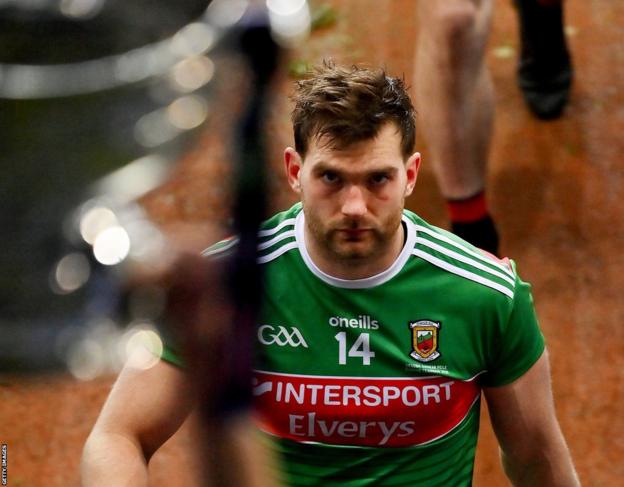
Anthony Hennigan is sports editor of the Western People newspaper, Mayo's paper of record, and has followed the team, first as a fan, then as his job.
"Come final day, we just play terribly. This is what Mayo do," he said.
"Mayo bring you on such highs and then the lows are very low as well."
He feels the pain, but he does not believe a curse is to blame.
"The curse is a complete and utter mystery in the sense that it just appeared from somewhere," he added.
"To the best of my knowledge, this curse never existed until I think sometime around the early 2000s."
One of Hennigan's colleagues - the editor of the Western People - wrote a history of Mayo and went to Foxford, the town where the open-backed lorry is supposed to have crossed paths with the funeral procession in 1951.
"He interviewed a couple of dozen people from Foxford who have lived in Foxford all their lives. Going back as far as the 1920s and 1930s at the time," said Hennigan.
"In all his research for the book and with all the people he liaised with locally to pull this publication together, there was never any mention of the curse."
Whether there was truth to the curse or not, it was presumed to have ended in 2021.
Less than two weeks after Mayo's defeat by Tyrone in that year's final, Paddy Prendergast, the last man who played for Mayo that day,
But, while Prendergast had been the last surviving player from that match, he was not the last remaining man from the 1951 Mayo dressing room or, crucially, the victory lap that followed on the lorry.
"It was something very special. I was nervous that day to go out there in front of 80,000 people," said Dr Mick Loftus to Amazing Sports Stories.
Loftus did not get on the pitch in anger - he was an unused substitute, but very much part of the celebrations afterwards.
Aged 93, his memories of the day are hazy. He remembers returning to Barry's Hotel - Mayo's traditional base for All-Ireland finals then - and hitting the dessert trolley.
"After the senior final, we went down and had an ice cream," he added.
But this is not the first time he has been asked about that win and the events that followed.
BBC Northern Ireland's Mark Sidebottom has covered Gaelic football for 30 years and interviewed Loftus several times.
"He made light of the whole thing," Sidebottom remembered of his conversations about the alleged curse with Loftus.
"He went, 'It's all hullabaloo. I don't remember any funeral cortege and I certainly do not remember overtaking a funeral cortege' - so I thought that was that and that had put it to bed.
"But then he looked at me and he said, 'Of course, there was a whole lot of excitement. And just because I didn't see a funeral cortege doesn't mean that there wasn't one.'"
While Loftus could not say for certain if Mayo's lorry trip coincided with a Foxford resident making their own final journey, Arlene Crampsie thinks she can.
Crampsie is a geography lecturer from University College Dublin. In 2008 she started work on the Gaelic Athletic Association's (GAA) Oral History project, travelling across Ireland to talk with people about Gaelic football and their lives and memories.
She spoke to 140 people who were involved in Mayo's 1951 homecoming celebrations.
"Unless we've specifically asked about the curse, there's no reference to the curse. So, that I think in itself is significant," she said.
"These homecoming celebrations were very well-attended by large numbers of people. They remember those events, but nobody mentions being present when this curse was supposedly cast on the team."
Crampsie went further though in search of the source of the curse. If the living could not provide any clues, perhaps the dead could.
She looked at research into the local records of deaths around Foxford, the town where the curse was alleged to have been uttered.
There was one death on the weekend of Mayo's 1951 All-Ireland win, but the burial took place the following Wednesday. Mayo's celebrations are believed to have passed through town on the Tuesday.
It seems highly unlikely the two groups - one celebrating, the other mourning - could have met. But records are fallible, memories can distort, and proving something did not happen is harder than proving it did.
was one of his last. One of the great Gaelic football men, he was a referee and administrator as well as a player, serving as the GAA's president between 1985 and 1988.
And he never lost faith in his old team.
"I honestly think that we'll win," Loftus said when asked for a prediction on Mayo's chances in the 2023 Championship.
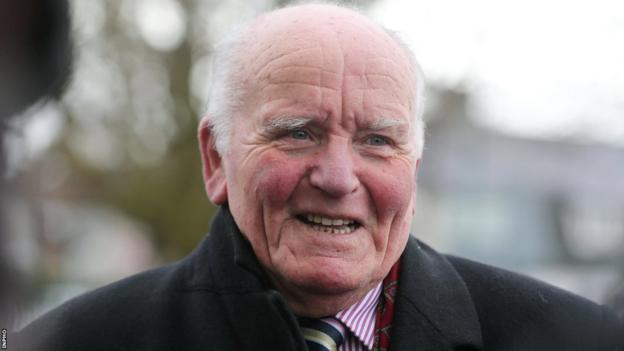
A month after his death, Mayo beat Kerry, the defending All-Ireland champions, on their way to the knockout rounds and Loftus' prediction looks as if it might just come true.
But then his team ran into Dublin, a juggernaut of a team who won six All-Ireland titles in a row between 2015 and 2020.
They lost, heavily. The barren run goes on.
Whatever remains of the curse, if it was ever a thing at all, is yet to be conclusively shattered.



